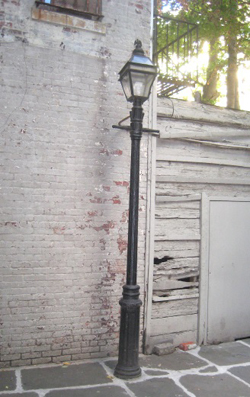Landmarked Lampposts
We often hear of historic districts, individual landmarked buildings and State and National Register sites. But did you know that there are sixty-two lampposts and four wall bracket lamps that have also achieved designated landmark status in New York City? (Of course, there are several more that are protected within historic districts or are on landmarked properties, but these sixty-two lampposts are individually designated posts, there to remind us of the streetscape from the last century.)
In 1997 the LPC conducted a survey of the remaining historic lampposts that were scattered around the city and discovered that approximately one hundred cast-iron lampposts still survived in the City of New York. Here is a brief historical overview of the New York City lampposts and how they came about:

In 1697, the Common Council of New York ordered homes to put lights in front of their windows that faced the streets in an attempt to illuminate the city. In 1772, the city imposed taxes to install plain wooden posts on the streets themselves, which were soon replaced by gaslights in 1823. Electric lights were introduced in 1880. With the technological advancements reaching their limit towards the end of the century, lighting companies began to focus more on the aesthetics of the lampposts, and the first set of ornamental models were installed in 1892 along Fifth Avenue.
The decorative design soon became standard for the posts — a simple, fluted, eight-foot base and shaft that was topped with a short, horizontal bar used as a ladder rest and surmounted by an eight-paned, polygonal lantern. During the early twentieth century, these posts quickly spread throughout the city, with only two remaining today; one of which is located at the foot of Patchin Place, a private brick home from the 20th century in the Greenwich Village Historic District.

During the 1950s and 1960s, many of these ornamental structures were replaced with the more modern steel and aluminum models. Fortunately, some have survived either by chance or have been preserved due to the efforts of the Friends of Cast-Iron Architecture. Now these lampposts stand as a reminder of the city’s street light history even if they are often to be found only in forgotten urban spaces or seem oddly charming in contrast to the surrounding modern buildings.

